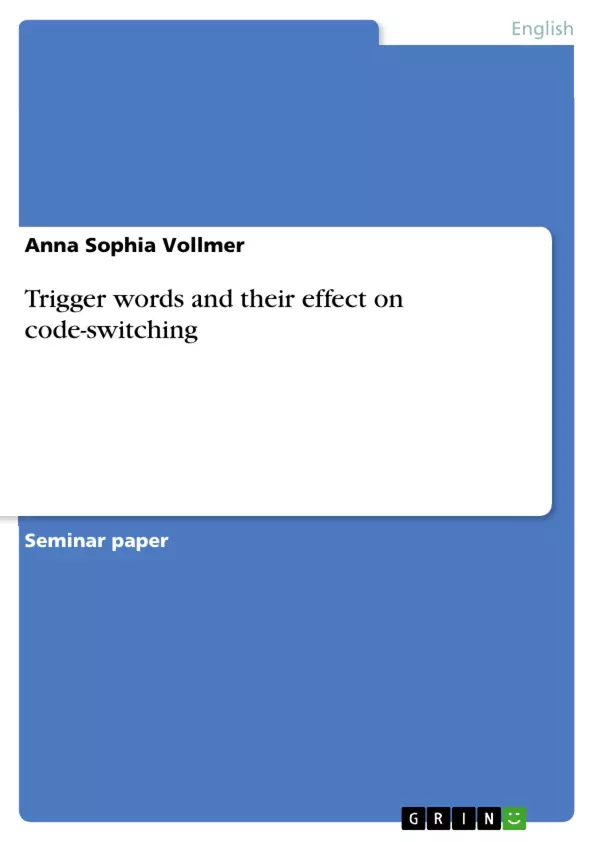It is not uncommon for bilinguals or multilinguals to sometimes switch back and forth between two or more different languages within a single conversation or even a single sentence. This phenomenon is called “code-switching”, and has been studied extensively from sociolinguistic and structural perspectives. In this paper, however, it will be examined from a psycholinguistic approach.
As code-switching occurs rather naturally and in informal settings, psycholinguists – who usually seem to prefer working with controlled data – tend to refrain from studying the psycholinguistic aspects of this phenomenon. Thus, unfortunately, much experimental data does not seem to exist in this research field so far.
Nonetheless, the study of code-switching with naturally occurring data could certainly provide some interesting insights into the cognitive processes of bilinguals when switching languages, and has thus been increasingly analyzed and evaluated with corpus data in recent years, for example, by Broersma & De Bot, 2006; Broersma, 2009, whose findings will be summarized and discussed in this paper. The aim here is to present support for language switches induced by so-called “trigger words”, and to analyze how and to what extent certain words can trigger code-switching.
Inhaltsverzeichnis (Table of Contents)
- Introduction: A psycholinguistic approach to code-switching
- The triggering hypothesis
- Types of triggering
- The triggering hypothesis in relation to speech production models
- Comparison of the two triggering hypotheses, their respective methodological approaches, and the evidence
- Code-switching in typologically unrelated languages: Dutch-Moroccan Arabic
- Codeswitching in typologically closely related languages: Dutch-English
- False cognates as trigger words
- Conclusion
Zielsetzung und Themenschwerpunkte (Objectives and Key Themes)
This paper investigates the psycholinguistic aspects of code-switching, focusing on the hypothesis that certain words can trigger language switches in bilingual speakers. It explores the triggering hypothesis, its relation to speech production models, and provides evidence from various studies.
- The triggering hypothesis and its different types of triggering
- The relationship between the triggering hypothesis and speech production models
- Empirical evidence from studies on code-switching in different language combinations
- The role of false cognates as trigger words
- Comparison and evaluation of different versions of the triggering hypothesis
Zusammenfassung der Kapitel (Chapter Summaries)
- Introduction: A psycholinguistic approach to code-switching: This chapter introduces the concept of code-switching and its focus on the psycholinguistic perspective. It discusses the limitations of existing research and highlights the importance of analyzing naturally occurring data. The chapter sets the stage for exploring the triggering hypothesis as a possible explanation for language switches.
- The triggering hypothesis: This chapter introduces Michael Clyne's triggering hypothesis, which suggests that certain words, particularly cognates, can trigger code-switching. It defines different types of triggering (consequential, anticipational, and sandwich words) and explains how these triggers can influence a speaker's linguistic orientation.
- Types of triggering: This chapter provides detailed descriptions of the three types of triggering proposed by Clyne: consequential, anticipational, and sandwich words. It illustrates each type with examples from real-world language use.
- The triggering hypothesis in relation to speech production models: This chapter examines the compatibility of Clyne's triggering hypothesis with more recent speech production models. It analyzes the theoretical underpinnings of these models and highlights potential areas of overlap and divergence.
- Comparison of the two triggering hypotheses, their respective methodological approaches, and the evidence: This chapter compares and contrasts Clyne's original triggering hypothesis with a revised version proposed by Broersma and De Bot. It discusses the methodological differences between the two approaches and presents evidence from empirical studies that support or challenge each hypothesis.
- Code-switching in typologically unrelated languages: Dutch-Moroccan Arabic: This chapter explores the application of the triggering hypothesis to code-switching between Dutch and Moroccan Arabic, two typologically unrelated languages. It examines the specific triggers and patterns observed in this language combination.
- Codeswitching in typologically closely related languages: Dutch-English: This chapter investigates code-switching between Dutch and English, two typologically closely related languages. It analyzes the influence of cognates and false cognates on language switches in this context.
- False cognates as trigger words: This chapter discusses the phenomenon of false cognates as potential triggers for code-switching. It explores how words with similar forms but different meanings can influence a speaker's language choice.
Schlüsselwörter (Keywords)
Code-switching, bilingualism, multilingualism, triggering hypothesis, trigger words, cognates, false cognates, speech production models, lemma level, Dutch-Moroccan Arabic, Dutch-English, psycholinguistics, corpus data, natural language.
- Quote paper
- Anna Sophia Vollmer (Author), 2017, Trigger words and their effect on code-switching, Munich, GRIN Verlag, https://www.grin.com/document/1010081



